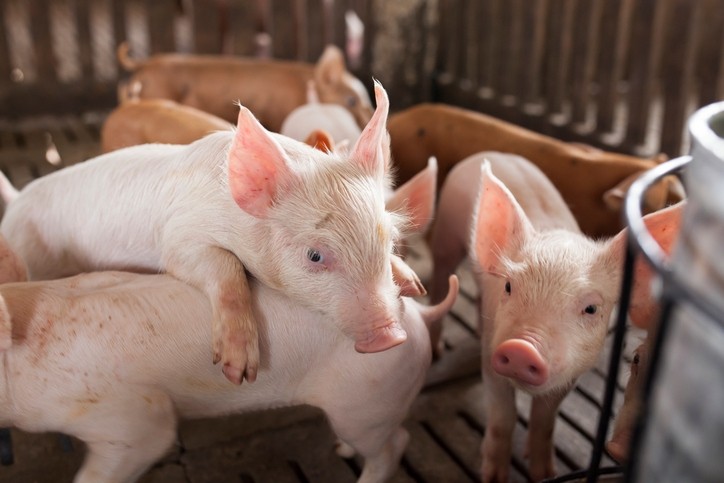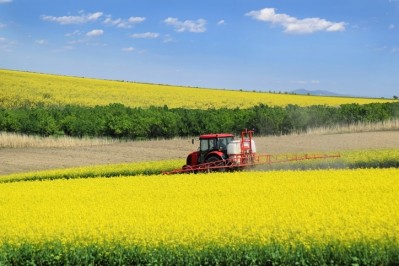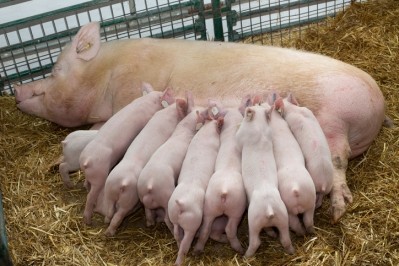Low net energy diets may result in lower feed costs while supporting swine production

Evaluation of lower net energy (NE) levels while using regionally relevant feeds was the focus of a study by Eduardo Beltranena, monogastric research scientist with the Alberta Department of Agriculture and Forestry, and colleagues.
Their previous work had indicated that reduced NE diets can be fed to growing-finishing pigs instead of traditional energy levels as long as pigs can increase feed intake to compensate (Smit et al 2017).
The latest study, published in Animal Feed Science and Technology, looked to confirm those findings and assess the use of canola meal (CM) and soy expeller cake (SE) in low NE and high NE diets, said Beltranena
Reducing feed costs is an important element for producers as feed is the largest cost in swine production, with energy-yielding ingredients accounting for 85-90% of the feed costs.
Both CM and SE are locally produced feedstuffs in Canada, and may provide an inexpensive way to reduce or increase the dietary energy level of swine feeds, according to the researchers.
The SE is high energy, while the canola meal is low energy and high in fiber, explained Beltranena.
Extruded-expelled soybean cake is now a locally produced feedstuff in Canada. Soy expeller does not go through the solvent extraction process so the resulting meal retains levels of soybean oil and has a greater energy value than imported soybean meal as a result.
Solvent-extracted canola meal (CM) has a low energy value because of its relatively high dietary fiber. These feedstuffs therefore offer the opportunity to either reduce or increase dietary energy level at low cost.
“We wanted to compare the two feedstuffs," said Beltranena.
Overall in the feeding trial, pigs getting the diet lower in energy had a higher feed intake, he told us.
“Pigs are able to increase feed intake consuming a cheaper diet and that’s what we're after,” he added.
Feed trial details
In the feeding trial 1,008 pigs were given one of four diets for a period of about 81 days or until market weight, the researchers said. Prior to the experiment, pigs had been raised on a series of wheat-based starter diets that did not include canola meal.
The diets included low NE (9.32/9.35 MJ/kg) diets for the grower and finisher phases or a high NE diet (9.90/10.24 MJ/kg), they said. Both types of diets included either solvent-extracted canola meal at 250 and 200 g/kg along with canola oil or soy expeller at 150 and 125 g/kg.
Feed intake was tracked during the trial, pigs were group weighed at the start of the period and on days 12, 33, 53, 74 and then twice weekly until reaching market weight, they said. Average daily feed intake (ADFI), average daily gain (ADG) and feed efficiency were calculated.
All pigs were harvested and warm carcass weight, backfat depth, loin depth, lean yield and carcass index were determined, said the researchers.
Results
The feeding trials found that pigs getting the low NE had greater feed intake than those on the high NE diets, and took in less energy overall. Regardless of energy level, pigs consumed more of the SE diet than CM, and grew slightly faster. Pigs getting diets with SE had greater loin depth, but energy level and protein source did not alter backfat depth, pork yield or carcass index.
“Feeding reduced NE diets to pigs did not result in major changes in growth performance,” said the researchers. “Abruptly introducing 250 g/kg CM in the grower phase diets was a challenge to pigs. Pigs fed CM never caught up to those fed more palatable, lower fiber SE.”
Average daily gain was similar for pigs on both low and high NE diets, the researchers said. However, ADG and the gain to feed ratio were improved for pigs getting the SE diet compared to the CM feed.
Over the entire length of the experiment, ADFI was similar for pigs getting SE or CM, although the NE intake was higher for those getting the soy-supplemented feed, they said. However, bodyweight was consistently higher for pigs getting the SE diets.
“In terms of the protein source, we were pleased to see that the feed intake was not different between the two protein sources,” said Beltranena.
“We got a little better growth rate and feed efficiency feeding the soy expeller than canola,” he said.
Pigs getting the diet with canola had a reaction to the amount of the feed ingredient being suddenly added to their food, he added.
“Usually we like to step the pigs into canola meal to get the pigs used to the taste,” he said. “[However,] the soy expeller is a terrific feedstuff in terms of the smell and the palatability – when you walk into the production facility it smells like popcorn – it’s not a surprise that pigs loved it.”
NE level was not found to alter the number of days it took pigs to reach market weight or loin depth, the researchers said. But carcass weights were lower, backfat thickness tended to be lower and lean yield was higher.
Pigs getting the SE diets reached market weight 2.6 days sooner than those getting the CM diet, they said. Pigs on the soy diet had greater carcass weight and loin depth.
However, in terms of profit returned for each pig, animals getting the low NE diets made more than those on the high NE diet and those on the SE diets earned about $0.30 more than those on a CM diet, the researchers said.
Feeding the lower energy diets may provide a way for producers to improve their profit per pig, said Beltranena. However, the practice would not be recommended if facing a disease challenge or for pigs facing heat stress.
“Lower costs diets can be fed to pigs as long as they can increase feed intake,” he said. “And we use what we have locally.”
Additionally, research is ongoing into the use of feed grains and oilseeds with minimal processing as part of an effort to improve the environmental footprint of animal production, he said. “We’re trying to do as little processing as we can with canola and soybeans to feed to pigs and poultry, though sometimes with the oilseeds the production of oil is for human consumption is the most profitable part of that – so we feed the meals,” he added.
Source: Animal Feed Science and Technology
Title: Effects of feeding canola meal or soy expeller at two dietary net energy levels on growth performance, dressing and carcass characteristics of barrows and gilts
Authors: M. Smit, J. Landero, M. Young, E. Beltranena
DOI: doi.org/10.1016/j.anifeedsci.2017.11.013












